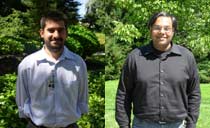
Handy Links
SLAC News Center
SLAC Today
- Subscribe
- Archives: Feb 2006-May 20, 2011
- Archives: May 23, 2011 and later
- Submit Feedback or Story Ideas
- About SLAC Today
SLAC News
Lab News
- Interactions
- Lightsources.org
- ILC NewsLine
- Int'l Science Grid This Week
- Fermilab Today
- Berkeley Lab News
- @brookhaven TODAY
- DOE Pulse
- CERN Courier
- DESY inForm
- US / LHC
SLAC Links
- Emergency
- Safety
- Policy Repository
- Site Entry Form

- Site Maps
- M & O Review
- Computing Status & Calendar
- SLAC Colloquium
- SLACspeak
- SLACspace
- SLAC Logo
- Café Menu
- Flea Market
- Web E-mail
- Marguerite Shuttle
- Discount Commuter Passes
-
Award Reporting Form
- SPIRES
- SciDoc
- Activity Groups
- Library
Stanford
Around the Bay
Panofsky Fellows Tackle Supernovae and Detector Triggers
 This year's Panofsky Fellows recently relocated to SLAC, but they're already immersed in their research.
This year's Panofsky Fellows recently relocated to SLAC, but they're already immersed in their research.
Saurabh Jha, in the Kavli Institute for Particle Astrophysics and Cosmology (KIPAC), works on more accurately measuring supernovae brightness, because it gives scientists a picture of how rapidly the universe is expanding. It turns out that the type of supernovae used as the yardstick is not always the same "length," so Jha looks for signs that a particular supernova is brighter or dimmer than normal.
"Making supernovae into better distance indicators will help us characterize the nature of dark energy that drives the accelerating Universe," Jha said.
He will be working with the Sloan Digital Sky Survey 2 and on developing analysis methods for the future Large Synoptic Survey Telescope.
Ariel Schwartzman is working on the innermost tracking detector of ATLAS, one of the new LHC experiments at CERN in Geneva. This pixel detector measures the trajectory of particles. He will work with SLAC colleagues to commission it next year, and is developing fast algorithms for which events should trigger the detector.
"We want triggering on b quarks, which are important signatures for new physics," he said. "We expect more than a thousand particles per collision. It's a very challenging environment."
—Heather Rock Woods
SLAC Today, August 18, 2006
Above image: Ariel Schwartzman and Saurabh Jha, the 2006 Panofsky Fellows.